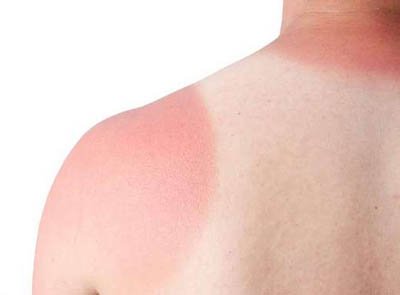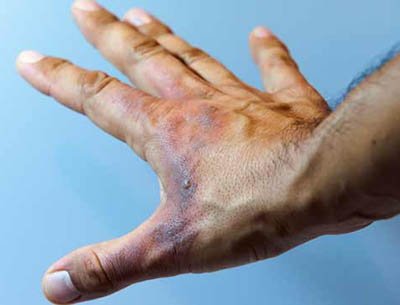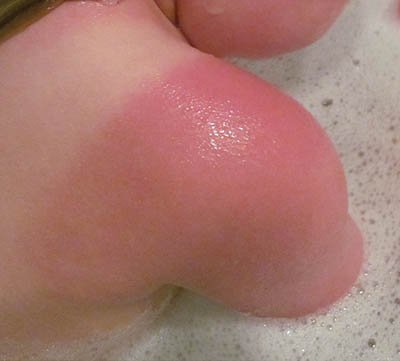The risk of burns is constant in everyday life. From solar to those caused directly by fire burns, there is a range of possibilities and risks. In this paper, the different types of burns and their severity and complications, options for burn treatment in Delhi and prevention are addressed.
We defined as burns injuries that occur in the skin as a result of the action of physical, thermal or chemical agents that cause cellular destruction of the skin, its annexes and even the tendons and muscles. In addition, burns cause swelling and fluid loss due to the destruction of the blood vessels are affected.
Types
 Sunburn
Sunburn
Electromagnetic radiation from the sun, only a portion reaches the surface of the Earth. Of these UVB radiation, wavelength between 280 and 320 nm, is about 0.1% of the radiation arriving from the sun and cause sunburn, although sunlight noon It contains a hundred times more UVA than UVB. This light has the ability to form the pigment tanning, or melanin, from the amino acid tyrosine. Melanin reaches the skin surface and has an oxidation which causes it to darken, known as indirect pigmentation, which is later but more durable than that produced by the UVA (320-400 nm) radiation.
In addition suntan and sunburn, UVB radiation is also responsible for the decline of the immune system of the skin, which becomes more susceptible to present the attack of pathogens such as herpes virus. This reductive action of the body defense system is also related to phototoxicity reactions to interact sunlight with certain chemicals and certain medications.
Burns accidental contact with liquids at elevated temperatures
This is one of the most common causes of severe burns, especially in young children. Hot liquids spread rapidly through the skin surface easily penetrating through deeper layers. Nature liquid fat (oils) are even more harmful, since they have greater adhesion to the skin.
Burns vapors and gases
Acute exposure to vapors and gases produced by combustion or boiling of various substances can cause burns to the skin surface and the exposed areas such as nose, throat or air zones.
Chemical burns
Caustic, acidic or alkaline substances cause burns when contacting the skin. In the case of contact with an alkali, the skin should not be in contact with water, as it can cause burns. Be especially careful with cleaning products commonly used, especially those containing ammonia or bleach, since they can cause serious eye injuries and skin.
Electrical burns
Electricity burns can be of two types: contact and flash. In the first case, a small but deep area is affected, with some tissue destruction, newly separated and shedding. On the contrary, burns and surface flashes affect a larger area of the skin, so for this type of burn treatment in Delhi is similar to superficial burns.
Injuries from an electric shock should be treated by a specialist, because, although they sometimes seem mild, can cause serious internal injuries. If the shock has been intense, heart rhythm disturbances can occur, since the heart functions with small electrical impulses, so could change the rhythm of the heartbeat and even cause cardiac and respiratory arrest.

Direct fire burns
With burns from contact with hot liquids, direct fire is the most common agent of severe burns.
The lesions produced by an electric discharge should be treated by a specialist because, although sometimes seem mild
Severity
Skin is one of the largest organs in the body and plays an important protective role against external agents and thermoregulation and sensitivity. Therefore, the loss or destruction of an important part of the skin is incompatible with life. the body needs a certain amount of heat to survive, but an excess or defect cause injuries when heat is transferred some limits. Thus, from 40ºC skin begins to show alterations and 70C and a small exposure causes destruction of the epidermis. When skin is exposed to intense heat dermatitis variable intensity, which can be classified into three different degrees occurs.
Scorch or first-degree
The best known of these types of burns example is typical sunburn, wherein surface congestion of blood vessels, swelling, warmth and pain variable and a reddening of the skin occurs and then the peeling. This type of burn produces minimal epithelial damage and usually heal spontaneously after 4 days without scarring, although there is a possibility that appears after hyperpigmented areas. It’s the kind of burn less severe prognosis.
Partial thickness burn or second-grade
It is always a burn that affects the dermis. edema of surface tissues due to transudation of serum from blood capillaries occurs. This accumulation of fluid under the outer layers of the skin causes the formation of vesicles and bullae on it. It causes swelling and severe pain. Their healing is slow and may also result in a permanent loss of skin adnexa such as hair follicles, sweat glands and sebaceous glands.
Third-degree burn
It is a burn poor prognosis, since in this case a loss of tissue occurs throughout the thickness of the skin (and skin appendages all), compromising sensitivity. Also it affects adipose tissue, nerves, muscles and even bone, so there are no epithelial tissue for skin regeneration.
Therefore, when this burn occurs ulceration, a dry, whitish or black eschar (frequently observed carbonized areas, black or dehydrated color, whitish) originates. It may be accompanied by severe pain around the burn or if there has been no great damage to nerve tissue in the area.
Just leaving sequels and atrophic scars visible parts, hypertrophic or keloid. The severity of this type of burn is variable, depending on the extent or affected area, its depth and, of course, its location.
It should also be borne in mind that the lesion may evolve in the next 24-48 hours, in the presence of edema difficult to know exactly its depth.
In general, the prognosis is worse when it affects more vascular tissue and is considered especially severe for life if they have burned more than two-thirds of the body surface.
They are also more serious injuries in the elderly, during pregnancy or postpartum period or in patients with cardiovascular disorders. In this type of burn it is necessary to perform skin grafts to restore normality.
We must bear in mind that the lesion may evolve in the next 24-48 hours, in the presence of edema difficult to know exactly its depth.
In addition to the depth reaching a burn and age of the patient, to assess the prognosis or severity of a burn, one must take into account the area affected by this surface. To do this, one method that has been used traditionally is the “Rule of Nine Wallace” (Table 1), in which the different areas of the body are represented by extension a multiple of 9% of the body surface Total (this calculation is not valid in the case of children, mostly cranial surface and shorter limbs).
Depending on all these variables classify the severity of burns:
Minor burns. They are the first-degree or second-degree surface with less than 15% extension (10% in children) and the third-degree with less than 1% extension.
Moderate burns. They are the second grade with 15-30% extension or third degree with less than 10% extension.
Severe burns. They are the second level with an extension exceeding 30%, the third degree with more than 10% extension and deep power.
Complications
It should be borne in mind that after severe burn injury must wait about 24 hours to rule out symptoms of shock and toxemia due to the absorption of necrotic tissue from the burned skin. The shock hypovolemic is the major systemic complications, whose appearance depends on the extent of the burn.
It can occur from 20% body surface area affected adults and 10% in children. Is fluid loss to the outside from the vessels and interstitial space destroyed, especially in the first 48 hours. The most characteristic symptoms are hypothermia, pallor, cold sweating, thirst and anxiety and tachycardia over 100 beats per minute. In case of shock, It must be called urgently for an ambulance, if possible, intensive care.
Other major complications of burns are loss of whey proteins and electrolyte imbalance with a significant drop in osmotic pressure which can lead to hemodynamic insufficiency. The shock is associated with the onset of tachycardia and hypotension.
One of the more serious complications is acute renal failure due to reduced oxygen supply to the tissues, which can lead to death. In addition, the shock hypovolemic may be complicated by the occurrence of a shock septic caused by microorganisms, often by Pseudomonas.
Not to forget they are great risks of wound infection due to contamination with bacteria both gram-positive (staphylococci and streptococci) and Gram-negative sepsis and may occur with spread to other vital organs. Superinfection of wounds delays and complicates the healing of these and can cause keloids.
Burn Treatment in Delhi
If the burns are mild and affect a small area of the body surface they can be treated on an outpatient except regime in case there are inhalation injuries. They are considered minor burns those first or second surface grade (extension less than 15% of the body surface in adults and 10% in children), the deep second degree (lower extension 10% of the body surface not affect vital areas) and third-degree affecting less than 1% of the total body surface. In the rest of burns will proceed to hospitalization.
The outpatient requires a detailed physical examination to rule out possible complications, assess the degree of skin condition and questioning the patient on what has been the causative agent, when the burn occurred, and so on.

Initial care
Regarding the care that must have the patient at home while the doctor’s arrival is expected, it is, above all, ensure that the cause of the burn has been eliminated, removing the person from the heat source, extinguishing the flames in the clothes with water or wrapping the patient with a blanket to smother the fire (to be avoided the uneven run, as this will cause the fire further fuel).
Before a chemical burn, the first precaution to take is to remove the affected area clothing and substances that may have become contaminated. Then also carefully remove rings, bracelets, belts and watch or other tight clothing remaining in the affected before the edema or swelling in the area occurs area.
Then check that the patient breathes. If it does and if necessary, initiate resuscitation. If suspected inhalation of large amounts of carbon monoxide, it should be administered oxygen via a face mask.
In no case should apply ice directly on the burned area, since it could increase damage to skin
Also, more effective burn treatment in Delhi is urgently cool the burned by local application of cold, for example by cold water, ensuring that the water jet does not directly impinge on the area burned area. You can also soak the affected area with cold compresses or cool area.
Cooling the burn decreases swelling by absorbing the heat of the skin. The application of cold water should be prolonged until the suspension again not show pain.
In no case should apply ice directly on the burned area, since it could increase damage to the skin. Nor is it advisable to apply creams or ointments, especially oils, as they increase the heat in the area and thus aggravate the process and predispose an infection.
Then, should proceed to remove dead skin debris and clean with soap and water gently. Also, keep in mind that, before a second-degree burn, you should never proceed to open or empty vesicles or blisters because the wound could become contaminated by microorganisms more easily.
If necessary, always indicated by a plastic surgeon in Delhi, the blister fluid may be evacuated by puncture with a sterile needle and the ampule must be subsequently treated with an antibiotic.
There are some ointments or solutions containing bactericides to prevent infection. an ointment with wound healing and antibiotic, or if the burning pain febrile is recommended, it can be applied with a spray healing and anaesthetic. An excellent healing is gotu kola.
Then it is advisable to cover the injured area with a light gauze dressing sterilized ointment enough to prevent it from adhering to the surface of the wound area. This prevents the burn dressing in contact with the air and reduces pain. It can be attached with a loose gauze bandage.
When burning hands or feet occur, it is advisable to separate each finger with a wet gauze before putting the band. Also, if necessary it may be given an analgesic to reduce pain (taking into account the indications or contraindications).
In the event that there has been a chemical burn that affects the eyes, it should immediately wash with running water for about twenty minutes. Then it is advisable to cover them with a damp gauze without pressure and then go to a medical center.
In case there are burns to the face, it must be covered with sterile gauze leaving openings for the mouth, nose and eyes. After this initial care, transport the patient to the nearest doctor or consult with the medical centre. It is always advisable to see a doctor, even if they are minor burns, so he can show us the proper burn treatment in Delhi, as well as accompanying measures (antibiotics, analgesics, tetanus), be taken.
To prevent injuries caused by the sun, we must remember that children under three years are particularly susceptible to this type of burns
Prevention
Most burns are due to home accidents caused by carelessness. The (under three years) Young children are the most affected. Usually, the accident occurs in the presence of a family member and the main cause of sunburn in children is contact with hot liquids in the kitchen (when left too close to the edge, within reach of the child and accidentally poured over).
In much smaller burns it occurs by direct heat, chemicals or electricity. Thus, the most common locations of the burns are the arms, legs, upper body and head. These data indicate the importance of the family in preventing burns and the need to eliminate overconfidence when adults handle hazardous substances in the presence of the smallest.
Finally, to prevent injuries caused by the sun, we must remember that children under three years are particularly susceptible to this type of burn, so they should not be exposed to direct sunlight and even in the shade (the clouds do not prevent sunlight from acting on the skin) must be protected with maximum product protection factor, not to mention the use of a cap, sunglasses and fresh clothing covering sensitive areas.
Also remember that the hours of maximum insolation range from 12.00 to 16.00, and that the risk of burns in the high mountains or the open sea is high. It should also be borne in mind that the beach sand or grass reflects radiation increasing its harmful effects on the skin.
